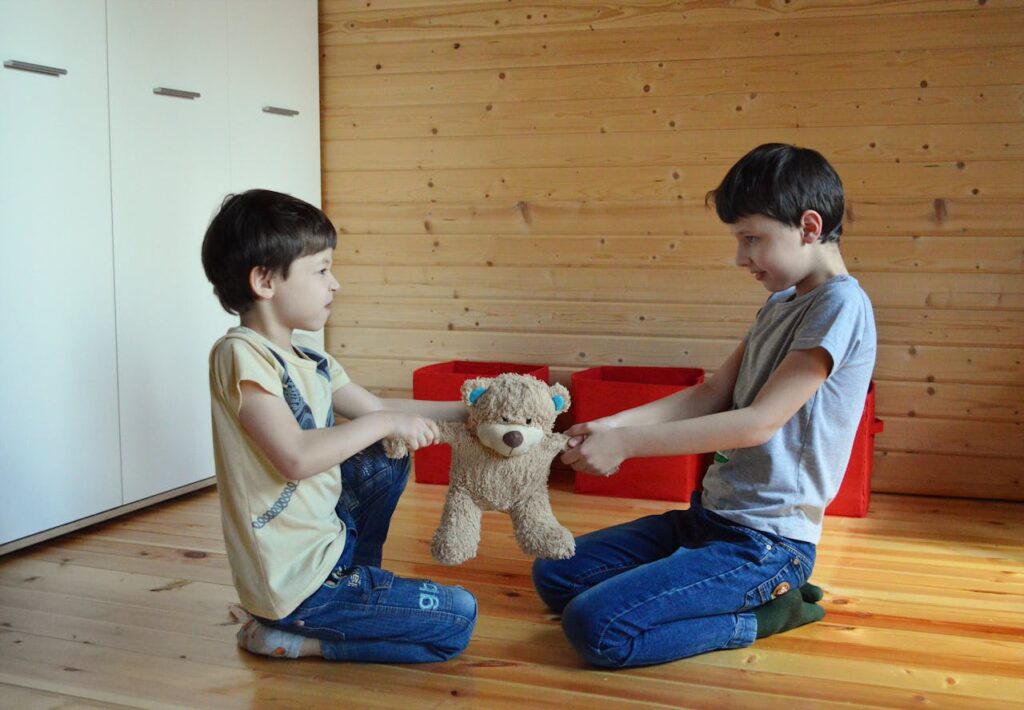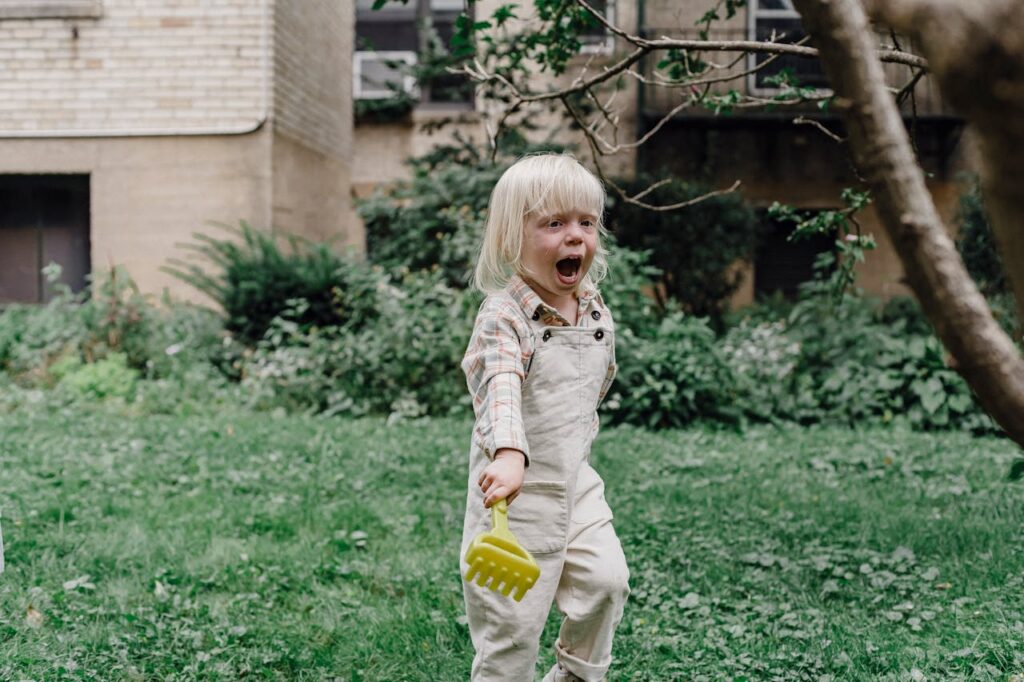When a child is emotionally overwhelmed, a tantrum is the natural response. Tantrums are quite common in young children from 18 to 24 months, but tantrums at 5 years old can be much more worrying for parents. You may find yourself wondering: Why is your 5 year old tantruming? Is it normal for a 5 year old to throw a tantrum or have frequent tantrums? The good and bad news is that 5 year old tantrums are absolutely normal.
A recent study revealed that over 80% of children from 3-5 years old tantrum at least once a month. While tantrums is less frequent in children 5 and older, your child can still be emotionally overwhelmed so it’s important to know how to deal with tantrums in 5 year olds.
The key to handling tantrums is to understanding them and nurturing your child to handle their emotions in a healthier way. We will help you explore the potential causes for tantrums, the parenting solutions, and how to help young children choose different behaviors in the future.
Understanding Temper Tantrums in 5-Year-Olds
The best way to manage a temper tantrum is to understand it. Children usually tantrum when they are overwhelmed with upset feelings. A child’s feelings can be stronger than they know how to handle. 5 year old tantrums often occur when your child is feeling something they don’t know how to express. The tantrum might even scare your child, and they are often in need of comfort and guidance instead of punishment.

Credit: Pexels
Are Tantrums in 5-Year-Olds Normal?
Tantrums are a typical part of development for 5 year olds. Tantrums that include screaming, flopping, flailing, and hitting are expressions of negative emotions that the child has no better way to express. A child’s tantrums reflect the child’s emotions, and acting out is perfectly normal.
Parents dealing with 5 year old temper tantrums should rest assured that your child’s behavior is not unusual. Over 80% of 5 year olds tantrum occasionally, and some tantrum more frequently because there is a need or emotional trigger that has not yet been resolved.
Causes of Tantrums in a 5-Year-Old Child
What can trigger tantrums at 5 years old? It’s important to consider that any disruption or negative emotion might be the trigger. Child development research has revealed that tantrums are a normal part of childhood and stem from environmental or personal causes that result in strong emotions. Some children are hypersensitive and easily overwhelmed. Poor sleep, a troubled family life, or incomplete coping mechanisms can all result in tantrums at 5 years old, as well as in younger children and even in school-age children, though less frequently.
Let’s take a closer look at the most common causes for 5 year old temper tantrums.
Emotional and Psychological Causes
Children don’t know how to express themselves fully, yet. This can be frustrating and the desire to express unhappiness can snowball into a tantrum. This is why teaching emotional words can be so important.
Possible psychological triggers for a tantrum include a desire for more independence or a need for more parental guidance. Childen may be developing self-identity and autonomy, but are unsure how to actually get what they want. This can lead to emphatic power struggles with parents.
Young children often also struggle with emotional regulation and impulse control. Understanding their own emotions is not easy, and the strong feeling can take over your little one before they know how to say “I’m upset, and here’s why.”
Physical Causes of Tantrums in 5 Year Olds
It’s also important to consider how your child’s physical needs may be causing tantrums. Children who are hungry or overtired are more likely to throw tantrums because physical needs can generate negative emotions. Small children can also become overstimulated in a busy environment or after a long day, and the tantrum may ironically be a request for a little peace and quiet.
Physical discomfort can trigger tantrums. Scratchy clothes or even summer bug bites can increase a child’s frustration level until they’re ready to scream. And really, we’ve all been there.
It’s important to provide your child with a consistent routine and a stable environment they can count on. That routine should include careful attending to the child’s diet, sleep requirements, and daily physical activity to create a positive influence on their mood and behavior. A good bedtime routine and a safe place can make a big difference if your child is experiencing intense feelings.
Environmental Causes
There are also a few environmental situations that can make a tantrum or meltdown more likely. Changes in routine, conflicts in the family, or fighting with siblings can all build up a sense of conflict, anger, or frustration in your young child. Tantrums in 5-year-olds can easily be an expression of overstimulation. Daily life can generate some big feelings in early childhood that can become overwhelming and grow into a tantrum.
Solutions for Managing Tantrums in 5-Year-Olds
When your child is going through tantrums at 5 years old, youl will need some management tools. 5-year-olds are big enough to get into real trouble when they start to scream and thrash. Toddler tantrums are no longer an excuse; it’s time for them to develop coping skills to manage those big feelings before they start school. The good news is that yelling and getting upset are not how to deal with tantrums in 5 year olds.
Parents will find the best results with parenting-expert approved techniques to manage the tantrums. The next step is to help your child calm down and teach them the appropriate way to express their upset feelings.
How To Deal With Tantrums in 5 Year Olds
Thre are two important goals when dealing with tantrums at 5 years old. The first is gently calming down your child when they start to tantrum. The second is building long-term strategies to prevent or handle those tantrum moments in the future by giving your child the tools for emotional self-regulation. 5 year olds are old enough to start learning about self-regulation and problem-solving.
Immediate Strategies: Stay calm and composed during a tantrum, even if it happens in a public place. You might feel like a bad parent, but you’re not. Panicking or giving too much attention might make the child’s behavior even worse. If your child is thrashing dangerously, wrap them in a hug and sit on the ground. Acknowledge that they are upset and gently describe why they are upset. You can also model how to calm down (which you may need) to show your child how it’s done.
- “I know you’re tired and want to go home. We can go home soon, but first we need to calm down.”
- “Let’s take a deep breath. 1… 2… 3… 4… 5… I feel better now. Do you need a few more breaths?”
Long-Term Strategies: In the long-term, it’s important to help your child build the ability to identify and describe their emotions. You should then guide them through learning self-regulation and problem-solving skills. Establish clear and consistent boundaries and teach your child to establish boundaries when they are needed. Discuss the tantrum with your child afterward to help understand their feelings. Don’t forget to reinforce positive behavior and set behavior expectations for the future. Do not use time-outs, but do give your child a quiet space they can choose to go to for calming down.
- “When you feel like that, you are frustrated that you can’t play more. That’s OK, we all want to play more. But sometimes we have to change activities, and sometimes things change before you feel like you’re done.”
- “When you start to feel upset, close your eyes and take a deep breath. Then try to describe what is upsetting you instead of yelling.”
- “When I’m upset, I need some quiet time. If you need quiet time, you can always go to the big soft chair and close your eyes.”
- “I saw you taking deep breaths when your brother knocked over the blocks. You did a good job not getting upset.”

Credit: Pexels
How To Calm a 5-Year-Old Tantrum
The best way to stop 5 year old tantrums is with firm calming techniques. Yelling back, spanking, and isolating time outs are not the way. Pediatricians have found that these methods usually make the tantrum worse, and more likely to happen again. Studies have also shown that yelling only makes you angrier.
Instead, tantrums at 5 years old can usually be calmed with hugs – sometimes heavy floor hugs – soft but firm talking, and acknowledging your child’s upset. Say things like “I know you’re upset because… ” and “It’s OK to be upset, but we don’t shout these feelings” and “Let’s calm down together.”
Describe the feelings to your child to give them the words to describe their own feelings. Take deep breaths together. If your child is flailing, hitting, or throwing, wrap them in a big hug and sit with them until they calm. This will help your child feel loved, safe, and understand that they won’t get a rise out of you by yelling more.
Techniques for Soothing and Calming
- Deep Breathing: Breathe deeply together on a count. Start deep breathing before your child works up to a full tantrum.
- Mindfulness: Mindfulness can help stop tantrums at 5 years old through quiet awareness of self and surroundings.
- The Calming Place: Give your child a special quiet, soft place they can go to calm down on purpose. This must be voluntary, not a time out spot but a safe space.
- Comfort Activities: Reading, listening to music, or playing with a favorite soft toy can be comfort and calming activities to pursue before tantrums in 5 year olds or after claming down.
- Angry Nap: Let your child know it’s OK to take an angry nap and wake up feeling better. Angry naps are great.
Building a Calming Toolkit
If tantrums at 5 yars old is a common worry, parents can build themselves a personalized toolkit for calming. Include items and activities that help soothe your child.
- Checklist of triggers and pre-tantrum behaviors: Triggers include missed naps, changed plans, or sibling fighting. Behaviors include huffing, slamming, and incrased volume.
- Calming toys and activities: Deep breaths, mediation, or going for a walk are examples of ways to help your child calm before or during a 5 year old tantrum.
- Pre-tantrum talk: Things you can say to help your child express their frustration in words before a tantrum.
How To Avoid Tantrums at 5 Years Old
Preventing and avoiding tantrums at 5 years old relies on removing triggers and heading off tantrums before they reach full force. Making sure your child’s physical and emotional needs are met is square one. Teaching emotional communication and self-regulating techniques is the second step. Lastly, watch out for triggers and help your child cope with upset feelings before they become full-blown tantrums.
1. Establish Routine & Consistency
It is important to build a stable daily routine. Confusion, disruption, and disappointment can all contribute to tantrums in 5 year olds. Make sure your child knows what to expect and experiences the safe reassurance of structure each day. Maintain your routine, keep your promises, and ensure your child has meals, playtime, bedtime, and wake-up all at the same times each day.
Building a visual schedule can help you and your child. Put a colorful schedule on the fridge, then use magnets and a toddler clock to keep track of the day. As a bonus, you can start teaching your five year old to tell time.
2. Encourage Positive Behavior
Don’t forget the power of positive reinforcement. Congratulate your child on handling upsetting situations calmly and maturely. Identify and positively recognize that they are using the coping and self-regulating skills you taught them. Mention that you are happy that they feel good about using their calm-down space or asking for things instead of screaming about them.
Praise good behavior, encourage and emphasize your child’s ability to improve, and you will see a decrease in 5 year old tantrums.
3. Teach Emotional Regulation
Finally, focus on teaching your child to regulate their own emotions. Be a good role model and show them how you calm down when upsetting things happen. You can also build activities and exercises to develop emotional awareness.
- Make a game out of “how are you feeling” where each person describes their feelings, and why. Be sure to share your own feelings, and include other members of the family.
- Role play and model healthy emotional responses in a “what if” game.
- Reflect on “best” and “worst” things in the day during your bedtime routine. This teaches gratitude and opens the door to problem solving.
- Teach your children to self-calm when upset and to ask for things they want to be different. Ex: “I don’t like the scratchy shirt” or “I want the blue cup today.”
- Encourage conflict resolution. Teach siblings to apologize to each other and guide kids to come up with their own ways to make it better after a fight.

Credit: Pexels
Making It Through 5 Year Old Tantrums
Tantrums at 5 years old are still perfectly normal. However, your child is also old enough to start learning self-regulation, emotional communication, and problem-solving for situations that might trigger a tantrum.
Once you know how to deal with tantrums in 5 year olds, your child will start learning, as well. The best news of all is that if you approach tantrums with love and learning, they will soon fade as your child gains the ability to handle their emotions and ask for what they need. Be patient; older children have fewer tantrums. A 6-year-old will be much more cooperative than a 5-year-old or a 4-year-old.
Of course, it’s also recommended to seek support if tantrums are too frequent, too intense, or the cause is hard to pin down. ADHD could be a cause of frequent and intense temper tantrums. Pediatricians, other parents, caregivers or other parenting professionals are here to help you along the way. Stay positive on your parenting journey.
Struggling with tantrums? Join our online parenting class for practical solutions! If you have further questions, Sophie, our AI parenting expert, is here to assist you.
References
Harvard Law School. (2020). Negotiation with Your Children: How to Resolve Family Conflicts. Program of Negotiation. Retrieved November 29, 2022 from https://www.pon.harvard.edu/daily/conflict-resolution/negotiating-with-your-children-2/
Hughes, C, Devine, RT, Mesman, J, Blair, C. (2020). Understanding the terrible twos: A longitudinal investigation of the impact of early executive function and parent–child interactions. Developmental Science. 23(6). https://doi.org/10.1111/desc.12979
Nieman, P., & Shea, S. (2004). Effective discipline for children. Paediatrics & Child Health, 9(1), 37–41. https://doi.org/10.1093/pch/9.1.37
Van den Akker, A. L., Hoffenaar, P., & Overbeek, G. (2022, September 1). Temper tantrums in toddlers and preschoolers: Longitudinal associations with Adjustment Problems. Journal of developmental and behavioral pediatrics : JDBP. https://www.ncbi.nlm.nih.gov/pmc/articles/PMC9462137








